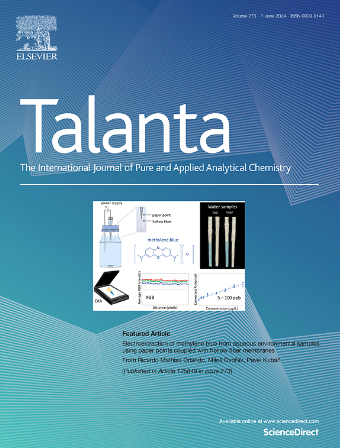“On-plant” wearable electrochemical sensor for atmospheric lead monitoring
IF 5.6
1区 化学
Q1 CHEMISTRY, ANALYTICAL
引用次数: 0
Abstract
Considering the extremely high toxicity of lead (Pb), early detection of atmospheric Pb levels is paramount for the implementation of preventive measures, to contain sources of emission, to minimize both human and plant exposure and to prevent accumulation in the biosphere. This work demonstrates a wearable “on-plant” sensor for electrochemical Pb detection in atmospheric aerosol samples. The sensor is screen-printed onto a flexible self-adhesive vinyl-based matte substrate which enables its attachment on plant leaves. It features a bismuth/Nafion-coated carbon working electrode transducer covered with a polyvinyl alcohol (PVA) membrane which serves as a passive in-situ gas collection layer and as an electrolyte-containing matrix. The Pb collected at the interface between the sample in the gas phase and the acetate buffer solution (ABS) embedded within the PVA membrane is measured by square wave anodic stripping voltammetry (SWASV). Different steps of the fabrication process were optimized and the detection of on plant leaves was demonstrated. Simulation experiments were conducted with a Pb-containing aerosol sprayed on the leaves to evaluate the effect of various operational parameters such as long-term stability, spraying time, accumulation time, or sensor/leaf bending. The “on-plant” sensor allows remote near real-time monitoring of Pb levels as low as 50 μg L−1 in ambient air using a portable miniaturized potentiostat, and can be expanded to other target metals, forming the basis of an early warning system for atmospheric heavy metals exposure.

求助全文
约1分钟内获得全文
求助全文
来源期刊

Talanta
化学-分析化学
CiteScore
12.30
自引率
4.90%
发文量
861
审稿时长
29 days
期刊介绍:
Talanta provides a forum for the publication of original research papers, short communications, and critical reviews in all branches of pure and applied analytical chemistry. Papers are evaluated based on established guidelines, including the fundamental nature of the study, scientific novelty, substantial improvement or advantage over existing technology or methods, and demonstrated analytical applicability. Original research papers on fundamental studies, and on novel sensor and instrumentation developments, are encouraged. Novel or improved applications in areas such as clinical and biological chemistry, environmental analysis, geochemistry, materials science and engineering, and analytical platforms for omics development are welcome.
Analytical performance of methods should be determined, including interference and matrix effects, and methods should be validated by comparison with a standard method, or analysis of a certified reference material. Simple spiking recoveries may not be sufficient. The developed method should especially comprise information on selectivity, sensitivity, detection limits, accuracy, and reliability. However, applying official validation or robustness studies to a routine method or technique does not necessarily constitute novelty. Proper statistical treatment of the data should be provided. Relevant literature should be cited, including related publications by the authors, and authors should discuss how their proposed methodology compares with previously reported methods.
 求助内容:
求助内容: 应助结果提醒方式:
应助结果提醒方式:


